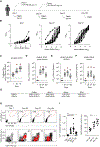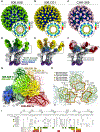A chikungunya virus-like particle vaccine induces broadly neutralizing and protective antibodies against alphaviruses in humans
- PMID: 37196061
- PMCID: PMC10562830
- DOI: 10.1126/scitranslmed.ade8273
A chikungunya virus-like particle vaccine induces broadly neutralizing and protective antibodies against alphaviruses in humans
Abstract
Chikungunya virus (CHIKV) is a mosquito-transmitted alphavirus that causes epidemics of acute and chronic musculoskeletal disease. Here, we analyzed the human B cell response to a CHIKV-like particle-adjuvanted vaccine (PXVX0317) from samples obtained from a phase 2 clinical trial in humans (NCT03483961). Immunization with PXVX0317 induced high levels of neutralizing antibody in serum against CHIKV and circulating antigen-specific B cells up to 6 months after immunization. Monoclonal antibodies (mAbs) generated from peripheral blood B cells of three PXVX0317-vaccinated individuals on day 57 after immunization potently neutralized CHIKV infection, and a subset of these inhibited multiple related arthritogenic alphaviruses. Epitope mapping and cryo-electron microscopy defined two broadly neutralizing mAbs that uniquely bind to the apex of the B domain of the E2 glycoprotein. These results demonstrate the inhibitory breadth and activity of the human B cell response induced by the PXVX0317 vaccine against CHIKV and potentially other related alphaviruses.
Conflict of interest statement
Figures






References
-
- Suhrbier A, Jaffar-Bandjee M-C, Gasque P, Arthritogenic alphaviruses--an overview. Nat. Rev. Rheumatol. 8, 420–429 (2012). - PubMed
-
- Burt FJ, Chen W, Miner JJ, Lenschow DJ, Merits A, Schnettler E, Kohl A, Rudd PA, Taylor A, Herrero LJ, Zaid A, Ng LFP, Mahalingam S, Chikungunya virus: an update on the biology and pathogenesis of this emerging pathogen. Lancet Infect. Dis. 17, e107–e117 (2017). - PubMed
Publication types
MeSH terms
Substances
Grants and funding
LinkOut - more resources
Full Text Sources
Medical
Miscellaneous

